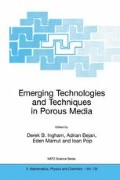Abstract
The concept of irreversibility is based on the second law of thermodynamics which serves to optimise the design of thermal, fluid and energy systems. The theories of reversibility and irreversibility are important in thermodynamics and crucial to the exergy method. Understanding the nature of irreversibility and how to minimise them in practice is essential for an engineering thermodynamicist. Contemporary engineering thermodynamics uses the rate of entropy generation as a parameter to quantify the significance of these irreversibilities. The local values of entropy generation due to viscous and thermal effects can be mapped to detect, by inspection, the key areas that requires a design modification. This emerging technology is viewed to have a meaningful potential for improving thermal systems design. In the thermal design decisions the utilisation of the second law of thermodynamics is very well referenced, see Bejan [5, 7]. Drost and White [8] studied numerical calculations of local entropy generation maps in an impinging jet whilst San et al. [15] studied entropy generation in convective heat and mass transfer within a smooth channel under some specific thermal boundary conditions. Baytas [2, 3] studied the optimisation in an inclined enclosure for minimum entropy generation in natural convection and Baytas and Pop [4] investigated the thermodynamic analysis of flow and heat transfer inside a trapezoidal cavity filled with a porous medium. Nag and Mukherjee [13]] studied thermodynamic optimisation of connective heat transfer through a duct with constant wall temperature
Access this chapter
Tax calculation will be finalised at checkout
Purchases are for personal use only
Preview
Unable to display preview. Download preview PDF.
References
Al-Hadhrami, A. K., Elliott, L. and Ingham, D. B. (2002). Combined free and forced convection in vertical channels of porous media. Transport in Porous Media, 49, 265–89.
Baytas, A. C. (1997). Optimisation in an inclined enclosure for minimum entropy generation in natural convection. J. Non-Equilib. Thermodyn., 22, 145–55.
Baytas, A. C. (2000). Entropy generation for natural convection in an inclined porous cavity. Int. J. Heat Mass Transfer, 43, 2089–99.
Baytas, A. C. and Pop, I. (1999). Free convection in oblique enclosures filled with a porous medium. Int. J. Heat Mass Transfer, 42, 1047–57.
Bejan, A. (1994). Entropy generation through heat and fluid flow (2nd edn). Wiley, New York.
Bejan, A. (1995). Convection heat transfer. Wiley, New York.
Bejan, A. (1996). Entropy generation minimisation. CRC Press, Boca Raton, FL.
Drost, M. K. and White, M. D. (1991). Numerical predictions of local entropy generation in an impinging jet. J. Heat Transfer, 113, 823–9.
Kaviany, M. (1985). Laminar flow through a porous channel boundary by isothermal parallel plates. Int. J. Heat Mass Transfer, 28, 851–8.
Kim, S. J. and Kim, D. (1999). Forced convection in microstructures for electronic equipment cooling. J. Heat Transfer, 121, 639–45.
Mahmud, S. and Fraser, R. A. (2002). Thermodynamic analysis of flow and heat transfer inside channel with two parallel plates. Exergy, Int. J., 2, 140–6.
Marafie, A. and Vafai, K. (2001). Analysis of non-Darcian effects on temperature differentials in porous media. Int. J. Heat Mass Transfer, 44, 4401–11.
Nag, P. K. and Mukherjee, P. (1987). Thermodynamic optimization of convective heat transfer through a duct with constant wall temperature. Int. J. Heat Mass Transfer, 30, 401–5.
Nield, D. A. and Bejan, A. (1999). Convection in porous media (2nd edn). Springer, New York.
San, J. Y., Worek, W. M. and Lavan, Z. (1987). Entropy generation in convective heat transfer and isothermal convective mass transfer. J. Heat Transfer, 109, 647–52.
Vafai, K. and Kim, S. J. (1989). Forced convection in a channel filled with a porous medium: an exact solution. J. Heat Transfer, 111, 1103–6.
Author information
Authors and Affiliations
Editor information
Editors and Affiliations
Rights and permissions
Copyright information
© 2004 Springer Science+Business Media Dordrecht
About this paper
Cite this paper
Baytas, A.C. (2004). Entropy Generation for Free and Forced Convection in a Porous Cavity and a Porous Channel. In: Ingham, D.B., Bejan, A., Mamut, E., Pop, I. (eds) Emerging Technologies and Techniques in Porous Media. NATO Science Series, vol 134. Springer, Dordrecht. https://doi.org/10.1007/978-94-007-0971-3_17
Download citation
DOI: https://doi.org/10.1007/978-94-007-0971-3_17
Publisher Name: Springer, Dordrecht
Print ISBN: 978-1-4020-1874-9
Online ISBN: 978-94-007-0971-3
eBook Packages: Springer Book Archive

